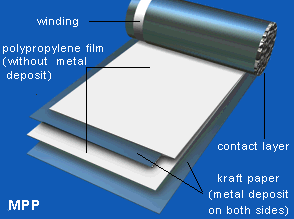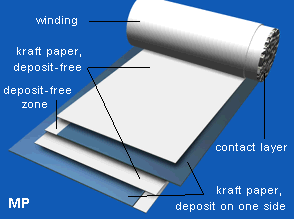MPP-Dielectric
The dielectric of MPP-type capacitors takes the form of a low-loss polypropylene foil immersed completely in mineral oil. Paper sheets which are metallized on
both sides serve as electrodes. MPP-capacitors are dried and impregnated in high vacuum.
Advantages of the MPP technology:
- The vacuum drying and impregnation procedure free the dielectric of any voids and minimise the occurrence of partial discharges. This results in long life-expectancy and
extremely stable electrical characteristics.
- The zinc contact layer forms a stable contact with the paper sheets and guarantees a very high resistance to impulse charges (a characteristic well-known from the MP-capacitor)
reducing the self-inductance of the capacitor.
- Extremely low losses through the application of polypropylene dielectric and the metallisation of both sides of the paper.
- The paper facilitates effective disposal of the products of decomposition, produced as a result of self-healing breakdown. This improves the self-healing qualities of the capacitor.
- Thanks to its low losses and the heat dissipation qualities of the oil impregnant, the capacitor may be operated at high ambient and case temperatures up to 70°C
without effecting the life of the capacitor.
- MPP power capacitors are particularly suited for use in detuned capacitor equipment.
The MPP-dielectric is preferred for highly stressed AC capacitors.
| MPP |
MP |
 |
 |
Self-Healing Dielectric:
Both dielectric structures (MKP and MPP) are "self-healing": In the event of a voltage breakdown the metal layers around the breakdown channel are evaporated by the
temperature of the electric arc that forms between the electrodes. They are removed within a few microseconds and pushed apart by the overpressure generated in the
centre of the breakdown spot. An insulation area is formed which is reliably resistive and voltage proof for all operating requirements of the capacitor. The capacitor remains
fully functional during and after the breakdown.
Home



